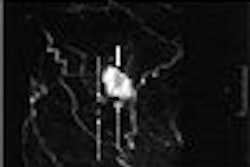(Radiology Review) Sonography and color Doppler sonography may be useful for differentiating acute appendicitis from appendiceal involvement in Crohn's disease, according to radiologists, whose research was published recently in the American Journal of Roentgenology (April 2006, Vol. 186:4, pp. 1071-1078). According to Dr. Tomás Ripollés and colleagues at Hospital Universitario Dr. Peset in Valencia, Spain, the correct diagnosis is important because acute appendicitis requires surgery.
During a five-year period, 190 patients with Crohn's disease were examined with ultrasound and features including "visualization of the appendix; thickness and color Doppler signal (grade 0, 1, or 2) of the appendix and adjacent intestinal loop (cecum, terminal ileum, or both); involvement of other intestinal segments; and abscesses" were assessed. The authors compared these features with the sonographic features of 49 consecutive patients diagnosed with acute appendicitis.
They retrospectively analyzed the results and discovered appendiceal involvement in 21% of patients with Crohn's disease. "All but one patient showed thickening of the terminal ileum, and 46% of patients also showed thickening of the cecum," they stated. The thickness of the anterior wall of the ileum was greater than 5 mm in 64%, and increased appendiceal Doppler flow was shown in 72%.
"Involvement of other segments was seen in 23 patients (59%) and adjacent abscesses in six (15%). Irregular thickness of the submucosa was seen in nine cases (23%) and fibrofatty proliferation in 19 (49%)," according to the authors. The two most valuable sonographic signs, ileum thickness of greater than 5 mm and Doppler flow in the ileum, resulted in a positive predictive value of 96% and a negative predictive value of 74% for diagnosing Crohn's disease involving the appendix and adjacent intestinal loop, and differentiating Crohn's disease from acute appendicitis.
The authors admitted to study limitations including lack of surgical proof, the retrospective nature of the study without Doppler standardization and several operators, and a bias toward patients with active Crohn's disease.
According to the authors, "sonographic appendiceal involvement in Crohn's disease is a relatively common feature (21%) and is usually associated with thickening of the ileum, cecum, or both." They recommend color Doppler of the appendiceal and bowel wall, as most patients with Crohn's involvement show Doppler flow and this may be useful for differentiation from acute appendicitis.
Tomás Ripollés et al
Department of Radiology, Hospital Universitario Dr. Peset, 90 Gaspar Aguilar Ave., Valencia 46017, Spain
AJR 2006, April; 186:1071-1078
By Radiology Review
June 20, 2006
Copyright © 2006 AuntMinnie.com



















